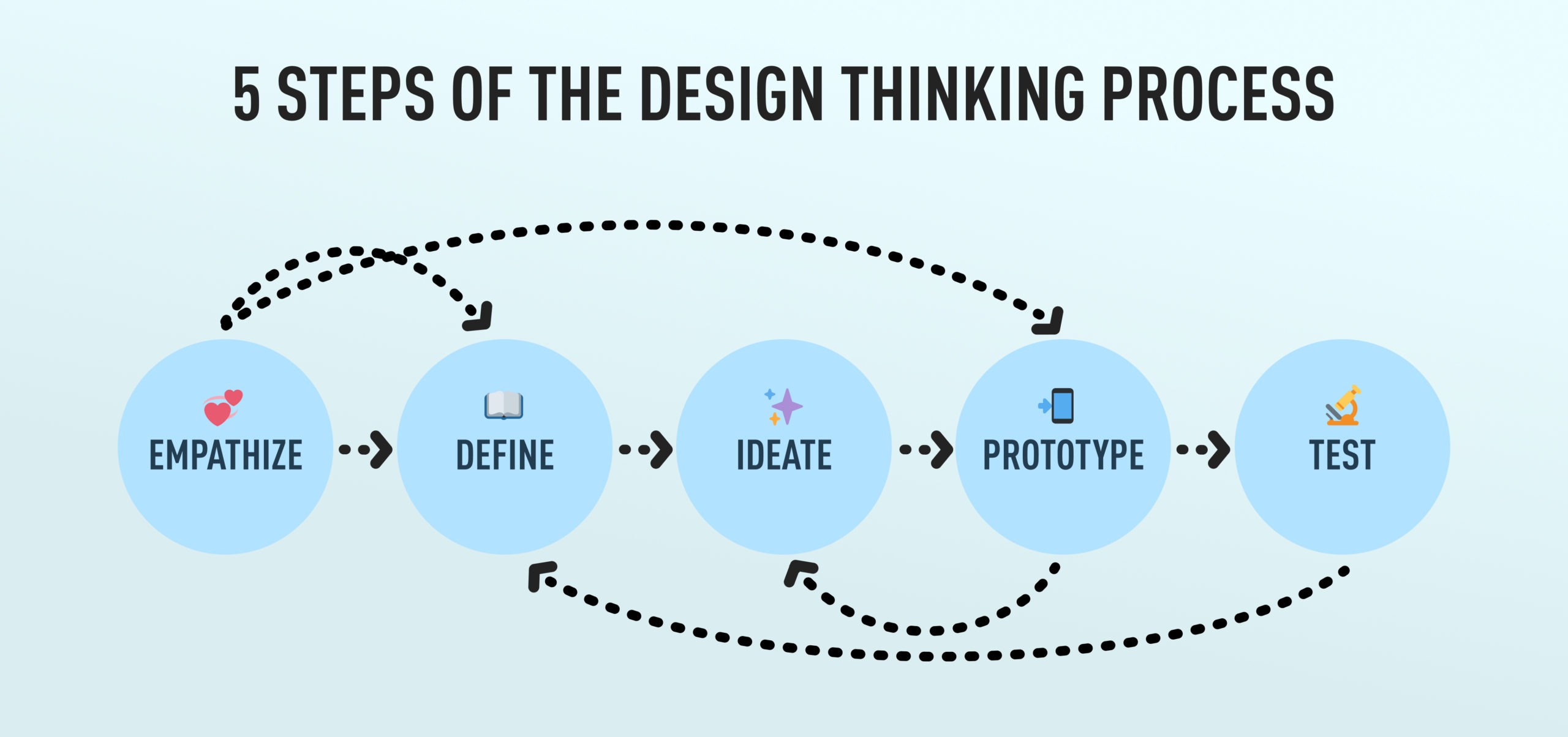Once you’ve empathized with your users, you can move on to the second stage of the Design Thinking process and define the problem your users need you to solve.
If you’ve read our introduction to User Experience (UX) Design, you’ll know that UX is essentially about solving the problems that prevent users from accomplishing what they want to do with our product.
Before you can go into problem-solving mode, however, there is one very crucial step that you need to complete—one that will shape your entire design project from start to finish. In the Design Thinking process, this step is what’s known as the “define” stage.
As the second step in the Design Thinking process, the define stage is where you’ll establish a clear idea of exactly which problem you will solve for the user. You’ll then shape this into a problem statement which will act as your northern star throughout the design process.
In this guide, we’ll tell you everything you need to know about this stage in the Design Thinking process, as well as how to define a meaningful problem statement.
Here’s what we’ll cover:
- What is the define stage and why is it necessary?
- What is a problem statement?
- How to define a meaningful problem statement
- What comes after the define phase?
Before we dive in, though, if you’d like an overview of the entire Design Thinking process, check out this video:
1. What is the define stage and why is it necessary?
As the second step in the Design Thinking process, the define stage is dedicated to defining the problem: what user problem will you be trying to solve? In other words, what is your design challenge?
The define stage is preceded by the empathize phase, where you’ll have learned as much about your users as possible, conducting interviews and using a variety of immersion and observation techniques. Once you have a good idea of who your users are and, most importantly, their wants, needs, and pain-points, you’re ready to turn this empathy into an actionable problem statement.
The relationship between the empathize and define stages can best be described in terms of analysis and synthesis. In the empathize phase, we use analysis to break down everything we observe and discover about our users into smaller, more manageable components—dividing their actions and behaviour into “what”, “why” and “how” categories, for example. In the define stage, we piece these components back together, synthesising our findings to create a detailed overall picture.
Why is the define stage so important?
The define stage ensures you fully understand the goal of your design project. It helps you to articulate your design problem, and provides a clear-cut objective to work towards. A meaningful, actionable problem statement will steer you in the right direction, helping you to kick-start the ideation process (see Stage Three of the Design Thinking process) and work your way towards a solution.
Without a well-defined problem statement, it’s hard to know what you’re aiming for. Your work will lack focus, and the final design will suffer. Not only that: in the absence of a clear problem statement, it’s extremely difficult to explain to stakeholders and team members exactly what you are trying to achieve.
With this in mind, let’s take a closer look at problem statements and how you can go about defining them.
2. What is a problem statement?
A problem statement identifies the gap between the current state (i.e. the problem) and the desired state (i.e. the goal) of a process or product. Within the design context, you can think of the user problem as an unmet need. By designing a solution that meets this need, you can satisfy the user and ensure a pleasant user experience.
A problem statement, or point of view (POV) statement, frames this problem (or need) in a way that is actionable for designers. It provides a clear description of the issue that the designer seeks to address, keeping the focus on the user at all times.
Problem or POV statements can take various formats, but the end goal is always the same: to guide the design team towards a feasible solution. Let’s take a look at some of the ways you might frame your design problem:
- From the user’s perspective: “I am a young working professional trying to eat healthily, but I’m struggling because I work long hours and don’t always have time to go grocery shopping and prepare my meals. This makes me feel frustrated and bad about myself.”
- From a user research perspective: “Busy working professionals need an easy, time-efficient way to eat healthily because they often work long hours and don’t have time to shop and meal prep.”
- Based on the four Ws—who, what, where, and why: “Our young working professional struggles to eat healthily during the week because she is working long hours. Our solution should deliver a quick and easy way for her to procure ingredients and prepare healthy meals that she can take to work.”
As you can see, each of these statements addresses the same issue—just in a slightly different way. As long as you focus on the user, what they need and why, it’s up to you how you choose to present and frame your design problem.
We’ll look at how to form your problem statement a little later on. Before we do, let’s consider some problem statement “do”s and “don’t”s.
What makes a good problem statement?
A good problem statement is human-centered and user-focused. Based on the insights you gathered in the empathize phase, it focuses on the users and their needs—not on product specifications or business outcomes. Here are some pointers that will help you create a meaningful problem statement:
- Focus on the user: The user and their needs should be front and center of your problem statement. Avoid statements that start with “we need to…” or “the product should”, instead concentrating on the user’s perspective: “Young working professionals need…”, as in the examples above.
- Keep it broad: A good problem statement leaves room for innovation and creative freedom. It’s important to keep it broad enough to invite a range of different ideas; avoid any references to specific solutions or technical requirements, for example.
- Make it manageable: At the same time, your problem statement should guide you and provide direction. If it’s too broad in terms of the user’s needs and goals, you’ll struggle to hone in on a suitable solution. So, don’t try to address too many user needs in one problem statement; prioritize and frame your problem accordingly.
Bearing these things in mind, let’s explore some useful methods for creating a meaningful problem statement.
3. How to write a meaningful problem statement
Writing a meaningful problem statement can be extremely challenging. How do you condense all the complexities of the user’s conscious and unconscious desires into one simple, actionable statement? Fortunately, there are some tried-and-tested methods that will help you do just that.
Space saturation and group
One of the first steps in defining a problem statement is to organize your findings from the empathize phase. Space saturation and group is a popular method used by design thinkers to collect and visually present all observations made in the empathize phase in one space. As the name suggests, you will literally “saturate” a wall or whiteboard with Post-It notes and images, resulting in a collage of artifacts from your user research.
As the Stanford d.school explains: “You space saturate to help you unpack thoughts and experiences into tangible and visual pieces of information that you surround yourself with to inform and inspire the design team. You group these findings to explore what themes and patterns emerge, and strive to move toward identifying meaningful needs of people and insights that will inform your design solutions.”
This method should involve anyone who took part in the empathize stage of the design project, and should take no longer than 20-30 minutes.
The four Ws
Asking the right questions will help you put your finger on the right problem statement. With all your findings from the empathize phase in one place, ask yourself the four Ws: Who, what, where, and why?
- Who is experiencing the problem? In other words, who is your target user; who will be the focus of your problem statement?
- What is the problem? Based on the observations you made during the empathize phase, what are the problems and pain-points that frequently came up? What task is the user trying to accomplish, and what’s standing in their way?
- Where does the problem present itself? In what space (physical or digital), situation or context is the user when they face this problem? Are there any other people involved?
- Why does it matter? Why is it important that this problem be solved? What value would a solution bring to the user, and to the business?
Approaching your observations with these four questions in mind will help you to identify patterns within your user research. In identifying the most prevalent issues, you’ll be one step closer to formulating a meaningful problem statement.
The five whys
Another question-based strategy, the five whys technique can help you delve deeper into the problem and drill down to the root cause. Once you’ve identified the root cause, you have something that you can act upon; somewhere specific to focus your problem-solving efforts.
Let’s take our previous example of the young working professional who wants to eat healthily, but finds it difficult to do so. Here’s how you might use the five whys to break the problem down and get to the root cause:
- Why is she not eating healthily? → She orders takeaway everyday.
- Why does she order takeaway everyday? → Her fridge and cupboards are empty.
- Why are the fridge and cupboards empty? → She hasn’t been grocery shopping in over a week.
- Why hasn’t she been grocery shopping? → She doesn’t have time to go to the supermarket.
- Why doesn’t she have time? → She works long hours and is exhausted.
The root cause here is a lack of time, so your solution might focus on efficiency and convenience. Your final problem statement might look something like this: “Young working professionals need a quick, convenient solution to eating healthily.”
4. What comes after the define phase?

By the end of the define phase, you’ll have turned your findings from the empathize stage into a meaningful, actionable problem statement. With your problem statement to hand, you’ll be ready to move on to the ideation phase, where you’ll turn your problem statement into “how might we” questions and generate as many potential solutions as possible.
As you move through the Design Thinking process, you’ll constantly refer back to your problem statement to make sure you’re moving in the right direction. A well-thought-out problem statement will keep you on track, help you communicate your objectives to key stakeholders, and ultimately lead you to that all-important user solution.
Want to learn more about designing user-friendly solutions? Check out these articles:
